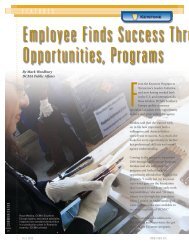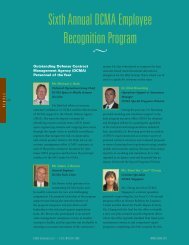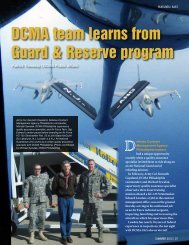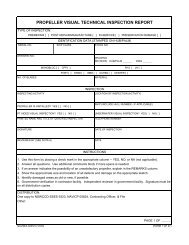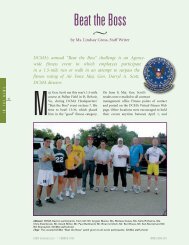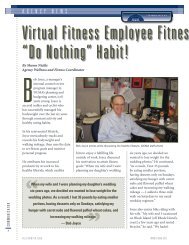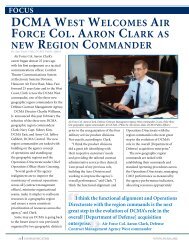Joint Strike Fighter - Lightning II Monthly Assessment Report - DCMA
Joint Strike Fighter - Lightning II Monthly Assessment Report - DCMA
Joint Strike Fighter - Lightning II Monthly Assessment Report - DCMA
Create successful ePaper yourself
Turn your PDF publications into a flip-book with our unique Google optimized e-Paper software.
<strong>Joint</strong> <strong>Strike</strong> <strong>Fighter</strong> - <strong>Lightning</strong> <strong>II</strong><br />
<strong>Monthly</strong> <strong>Assessment</strong> <strong>Report</strong><br />
Zia..<br />
Prepared for the <strong>Joint</strong> <strong>Strike</strong> <strong>Fighter</strong> Program Office (JSFPO)<br />
Prepared by <strong>DCMA</strong> Lockheed Martin Fort Worth<br />
NOOO 19-02-C-3002<br />
15 August 2007
Table of Contents<br />
1.0 JSF Executive Summary ................................................................................................... 3<br />
2.0 PBt\1 <strong>Assessment</strong> !V1atrix .................................................................................................. 4<br />
3.0 .......................................................................................................... 4<br />
4.0 .............................................................................................................................. 7<br />
5.0 Production / Airframe LMF\V ....................................................................................... 9<br />
0.0 Vehicle Systems .............................................................................................................. 11<br />
7.0 Mission Systems ............................................................................................................. 13<br />
8.0 Propulsion ....................................................................................................................... 15<br />
9.0 Earned Value................................................................................................................... 18<br />
10.0 Process Revie\vs ........................................................................................................... 20<br />
11.0 Appendix A ................................................................................................................... 21<br />
For Official Use Only - Proprietary Program l)ata Pag!.' 2 or21
1.0 JSF Executive Summary<br />
Lockheed Martin Aeronautics Company announced earlier this month that they had over billed<br />
the Government by $266M on the JSF SDD Program. LM Aero discovered this over billing<br />
during an internal audit, and stated they will reimburse the government for the principal amount<br />
and interest charges. The government has temporarily suspended direct billing activity, and is<br />
currently in the process of verifying Lockheed Martin Aeronautics' method of calculating the<br />
interest and principal tor the amount over billed.<br />
Return to tlight testing for A.A.-I will most likely occur in September. As of this reporting<br />
period, the design solution. delivery. and SOF qualification of the Inverter Converter Controller<br />
(ICC) and subsequent VSIF testing could potentially be the pacing item tor return to flight.<br />
Additional threats to return to flight are: delivery of -9 contiguration Electronic Units (EU's),<br />
Power Distribution Center (PDC) delivery, installation, and regression testing, along with FTU<br />
2.3 load and regression testing. Flight clearance approval must occur as well. The independent<br />
review team has concurred with using -9 EU's for return to flight, with a retrofit to -10 ElJ's<br />
occurring at a later date. Although the -9 EU confif,'Uring places a 33K' ceiling on flight<br />
activities, several valuable tests can still be accomplished, and are desired prior to the planned<br />
Edwards deployment in November for airstart and Power and Thermal Management Systems<br />
(PTMS) testing.<br />
12 Assembly<br />
3 Male<br />
4 - Assembly<br />
3 Mate<br />
5 Assembly<br />
I - Male<br />
3 (BF-I, BF-2 & BG-l)<br />
BF-1 - Lack of parts to support Major Mate activities and the potential for additional work<br />
around plans may impact October POWt:f on event. Wing completion remains critical - recovery<br />
plan progression is slower than originally anticipated. Current goal as of July ASMR is to get<br />
out of EMAS by -20 Oct 07 - this is dependent on lTF engineering releases and subsequent<br />
Wing systems installations. Other activities hampering BF-I completion are; FS270 bulkhead<br />
moditication kits to support completion of Center to Forward Mate, Chine Fairings to support<br />
completion of 556 Mate joint, CS&E deliveries needed for HT and VT assembly and installation,<br />
and Main Landing Gear skins (in-house make) lor completion of Center to Wing Mate. As of 12<br />
Aug 07. current threat to the 23 May 08 first flight date is estimated at -51 Mdays due to<br />
dependency of 8G-1 testing -- mitigation etforts to remove this threat are underway.<br />
For Official Use Only Proprietary Program Data Page 3 0(21
5.0 Production I Airframe - LMFW<br />
Technical Perfonnance Overall, Forward, Wing and Mate assembly pertonnance to t\1S05<br />
schedule is degrading. For example. as of 26 July 07, jig load dates have been missed in the<br />
Forward Fuselage for AF-3, A1-1, CF-I, CG-\ as well as AG-l, AF-2, and AF-3 in the Wing.<br />
Pertonnance is being impacted by: Critical part shortages, high change traffic, difticult work<br />
(fuel floors, chine fairings, MLG boring, warping/drooping bulkheads, etc.), and late and/or<br />
constant re\vork of planning. LM now projects that BF-2 and all tollow on Wings will move to<br />
mate 2-4 weeks later than originally planned. Current Wing touch labor assembly pertonnance<br />
to budget for BF-I is around 15k hours above original estimates.<br />
LM is currently working to an internal Shop Operating Plan (SOP) which they believe will bring<br />
them back into MS05 requirements. LM recently held an oftsite to assess their current schedule<br />
position, engineering, tools, and planning availability. From this offsitc they have identified four<br />
key tocus areas: increasing staffing, creating workable work packages tor the mechanics,<br />
establishing and deploying a rigorous production tempo and improving management and support<br />
team etliciency. In addition, planning and manufacturing engineers' resources are being added<br />
to improve support to the shop floor.<br />
For Official Use Only - Proprietary Program Data Page 9 of 21
6.0 Vehicle Systems<br />
Supplier Schedule - A total 0[20 components remain to be delivered which are required for BF<br />
1 initial power-on scheduled for 22 Oct 07. Of those. 16 components are deemed critical for<br />
execution.<br />
Tactical Navigation System - Suppher has concluded the <strong>Lightning</strong> Pt.'rfomlance test.<br />
Electro-Hydrostatic Actuation System- Electronic Unit (EU) rework (-9) is in progress and<br />
future deliveries are pianm,,'
WBS 1425 SW Productivity calculations are not shown because no hours charged to activities<br />
considered in the SW Productivity calculation.<br />
Green: :> -5% Variance<br />
Yellow: - 10 to -5% Variance<br />
Red: < -10% Variance<br />
Within the 1420 WBS' and considering only those hours since OTB, Block 0.1 is 94.2%, and<br />
Block 0.5 is 77.4% complete. Considering all hours since inception within 1420 WBS' (i.e.<br />
142X), Block 0.1 is 96.8%, and Block 0.5 is 79.5% complete.<br />
for Official Use Only - Proprietary Program Data Page 15 ofZl
9.0 Earned Value<br />
<strong>DCMA</strong> JSF - June 07 Data<br />
Lockheed is now reporting to an Over Target Baseline of reported in the Cost<br />
Perfonnance <strong>Report</strong> (CPR). The June 2007 cost summary is as follows:<br />
Pertonnance<br />
Measurement<br />
Baseline (PMB)<br />
1 i<br />
I<br />
.<br />
Management Reserve<br />
(MR)<br />
Total:<br />
BAC<br />
I<br />
.<br />
Table I. Budget Basehne and l:.Ae Summaries<br />
Primary Trip Wires:<br />
(a) System Indicator: The yellow raling is based on the tindings described in this report<br />
on Systemic Surveillance.<br />
For Official Use Only Proprietary I'rogram Data Page 18 of21
(b) Baseline Indicators: A baseline assessment shows the contractors BAC and EAC to be<br />
optimistic. To complete the contract within the CBB, the contractor needs to be about 12<br />
per cent more efficient. The BAC has increased by 3M;) since the start up in 2001. The<br />
cost growth is likely to increase due to inherent engineering risks in the first versions of<br />
STOVL and CV aircraft ,. .. .<br />
. Several of threats and pressure items in previous<br />
month have been downgraded to watch items. We have requested justitication and are<br />
awaiting the final disposition.<br />
Secondary Trip Wires:<br />
SPI= BCWP/BCWS=<br />
CPl= BCWPI ACWP=<br />
cPlrrcPI= 0.983/0.895= 1.098<br />
Contracts Mods - (BAC now}!original BAC 10/01<br />
The <strong>DCMA</strong> Risk Rating for EVMS at the total program level is rated yellow· using the agreed<br />
to parameter of VAC (-5.29%). Compare this to the Lockheed's EAC and one can see a<br />
difference ofover 5°10.<br />
Similarly, the TCPIEAc is different when using the <strong>DCMA</strong> IEAC versus the contractor's EAC:<br />
TCP1OCMA. IE-\('<br />
= 0.895<br />
TCPIL.. , EAC 1.016<br />
Cumulative to date SPI and CPI are at .988 and .983 compared to .990 and .982 in the previous<br />
month. Cumulative SV% and CV% are -1.21% and -1.71%, compared to -1.01% and -1.84% in<br />
previous month and are also rated green. Key <strong>DCMA</strong> IEAC drivers come from Production<br />
Engineering and Production Operations, Vehicle Systems, Airtrame, and Mission Systems. In<br />
Production Operations and Production Engineering, the main drivers are: Unfunded requirements<br />
tor Minor and Major Change Curves, I & R etfort, loss of Commonality, engineering changes<br />
and tooling growth. In Missions Systems, key drivers include: lssociated with change<br />
curve B implementation at risk (added scope and performance), additional Radar<br />
testing, and lCP work. For Vehicle Systems, the main drivers are: additional etlort for SW etlbrt<br />
to support AA-l flight test SPAR hum down. . _ .n<br />
Airframe, the main drivers are: latc release of engineering changes and greater than planned<br />
etfort for STOVL and CTOL BTPs. In Missions Systems, key drivers include: associated<br />
with change curve B implementation added scope and performance), additional Radar<br />
testing,<br />
Update: DeMA gave LM AeronautIcs Business Management 30 days from 18 Sep 06 to address<br />
an apparent lack of EAC updates with an action plan. The trend charts of both EAC and BAC<br />
provided as part of the JSF CPR indicated that there had been no cost growth on this program<br />
when. in fact, . _ . Cost growth<br />
enough, in point ()f fact, that EAC4 incorporates a number of program changes in order to bring<br />
the anticipated cost of the program down. That represented a violation of the EV Criteria that<br />
For Official lIse Only - Proprietary Program Data Page 19 of21
equires regular updates of the EAC when significant changes occur. Lockheed has provided<br />
that plan called '-' and<br />
<strong>DCMA</strong> is in the process of reviewing the response. Enough time has passed to test the maturity<br />
of the - :iatabase and we are beginning an assessment review based on the agreements<br />
made back in December. In support of our rl!view, - . , las<br />
indicated a failure of to include appropriate estimates for engineering and other<br />
configuration changes. These estimates should have been included in tt latabase and<br />
were not apparently found. This issue with ill become part of our review of the<br />
effectiveness oftl: the JSF proh'Tam. Please see the System Surveillance section for<br />
more information. rhe <strong>DCMA</strong> EV Center will be coming to LM Aeronautics for an EV<br />
Compliance Review. It is currently planned to occur during 20-31 Aug 07.<br />
The complete EV <strong>Report</strong> and subsequent System Surveillance information is attached:<br />
10.0 Process Reviews<br />
Membl!rs of the Product Assurance Design and Integration Team, <strong>DCMA</strong> LM Fort Worth,<br />
conductoo a review ofthe JSF Risk Management List - SEI-019. Analysis determined that WBS<br />
1422, External Communications, which has 82.5%1 of work to be performed, was the candidate<br />
for the review. The contractor was found to be tollowing their procedure as written and there<br />
were no major or minor findings with the process.<br />
Product Assurance team members conducted a review of the BTP Engineering Checking process<br />
as described in PM-4052, Sections, 11-2.7, 11-3.2 and 11-3A. The goal of the process is to<br />
ensure BTP discrepancies are captured and corrected prior to the approval process within the<br />
BTP release life cycle. No major or minor findings were discovered during the review.<br />
For Official Use Only Proprietary Program Data Page ZO of21



